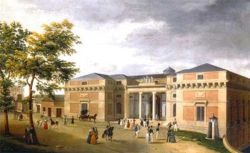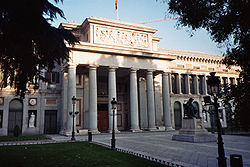
Juan de Villanueva
Encyclopedia

Spain
Spain , officially the Kingdom of Spain languages]] under the European Charter for Regional or Minority Languages. In each of these, Spain's official name is as follows:;;;;;;), is a country and member state of the European Union located in southwestern Europe on the Iberian Peninsula...
architect
Architect
An architect is a person trained in the planning, design and oversight of the construction of buildings. To practice architecture means to offer or render services in connection with the design and construction of a building, or group of buildings and the space within the site surrounding the...
. Alongside Ventura Rodríguez
Ventura Rodríguez
Ventura Rodríguez Tizón was a Spanish architect and artist. Born at Ciempozuelos, Rodríguez was the son of a bricklayer. In 1727, he collaborated with his father in the work at the Royal Palace of Aranjuez.-Major works:...
, Villanueva is the best known architect of Spanish Neoclassicism
Neoclassicism
Neoclassicism is the name given to Western movements in the decorative and visual arts, literature, theatre, music, and architecture that draw inspiration from the "classical" art and culture of Ancient Greece or Ancient Rome...
.
His father was the sculptor Juan de Villanueva and his brother, Diego de Villanueva was not only his protector, but also his teacher.
He entered into the Royal Academy of Fine Arts of San Fernando as a pupil when he was eleven years old. In 1758, he travelled to Rome
Rome
Rome is the capital of Italy and the country's largest and most populated city and comune, with over 2.7 million residents in . The city is located in the central-western portion of the Italian Peninsula, on the Tiber River within the Lazio region of Italy.Rome's history spans two and a half...
to become a grant holder of the Academy to complete his studies. In 1765, he returned to Spain.
A year later,he travelled through Córdoba
Córdoba, Spain
-History:The first trace of human presence in the area are remains of a Neanderthal Man, dating to c. 32,000 BC. In the 8th century BC, during the ancient Tartessos period, a pre-urban settlement existed. The population gradually learned copper and silver metallurgy...
and Granada
Granada
Granada is a city and the capital of the province of Granada, in the autonomous community of Andalusia, Spain. Granada is located at the foot of the Sierra Nevada mountains, at the confluence of three rivers, the Beiro, the Darro and the Genil. It sits at an elevation of 738 metres above sea...
, where he, together with José de Hermosilla, went to draw the "Arab antiquities." The drawings from these travels were published in 1804. He settled in Madrid, where he was appointed Academic of the Academy of San Fernando.
In 1777, Charles III
Charles III of Spain
Charles III was the King of Spain and the Spanish Indies from 1759 to 1788. He was the eldest son of Philip V of Spain and his second wife, the Princess Elisabeth Farnese...
appointed him Architect of the Prince and the Infants. From then to the end of his life he would work almost exclusively for the Royal House. In 1781, he was appointed Architect of the Royal Monastery of El Escorial, and Charles IV appointed him Major Architect. He was going to construct several pavilions for the royal disposal: in 1771, he built the Casa de Infantes in the Royal Site of Aranjuez; in 1772, the Casita del Príncipe, at El Pardo
El Pardo
The Royal Palace of El Pardo is a historical building near Madrid, Spain, in the present-day district of Fuencarral-El Pardo. Owned by the Spanish state and administered by the Patrimonio Nacional agency, the palace began as a hunting lodge.-Overview:...
; in 1773, the Casita de Arriba (with a Palladian scheme and a notable plasticity in the treatment for the main portal) and the Casita de Abajo or del Príncipe, both in El Escorial, where he also constructed the Casas de Oficios, a group of houses, according to the sober Herrerian
Herrerian
The Herrerian was developed in Spain during the last third of the 16th century under the reign of Philip II , and continued in force in the 17th century, but transformed by the Baroque current of the time...
style of the Monastery.

He was a prolific architect and he displayed the majority of his work in Madrid: buildings like the Academy of History, the Caballero de Gracia oratory, the Astronomical Observatory are remarkable. With his interventions in the Plaza Mayor, both after the fire of 1790 and in the Major House among others, he collabored in the renovation of the image of the city.
With his personal style and with his strong local influences, he was the architect who best brought the theorical basis of European Neoclassicism to Spain.
Main Works

- Casita de los Infantes, Aranjuez (1771)
- Casita de arribaCasita del InfanteThe Casita del Infante is a historical building in San Lorenzo de El Escorial, Spain, constructed as a private home for the Infante Gabriel of Spain, hence its name. The small residence was built during the late 18th century during the reign of his father Charles III of Spain...
, El Escorial (1773) - Casita de abajo, El Escorial (1773)
- Royal Botanical GardenReal Jardín Botánico de MadridThe is an botanical garden located at , next to the Prado Museum in Madrid ....
, Madrid (1774-1781) - Casita del Príncipe, El Pardo (1784)
- Casa de los Oficios, El Escorial (1785)
- Prado Museum, Madrid (1785)
- Academy of HistoryReal Academia de la HistoriaReal Academia de la Historia is a Spanish institution based in Madrid that studies history "ancient and modern, political, civil, ecclesiastical, military, scientific, of letters and arts, that is to say, the different branches of life, of civilisation, and of the culture of the Spanish...
, Madrid (1788) - Oratory of Caballero de Gracia, Madrid (1789)
- Major House of Madrid: Columned façade to the Calle Mayor, Madrid (1789)
- Astronomical ObservatorySpanish National ObservatoryThe Spanish National Observatory is an astronomical observatory with several facilities in the Madrid area.The historic building in the Parque del Buen Retiro was built in 1790 as the Royal Observatory...
, Madrid (1790) - Reconstruction of the Plaza Mayor, Madrid (1791)
- Príncipe Teater, Madrid (1804)
- General Cemetery of the North, Madrid (1804)

